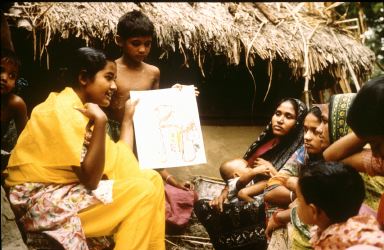The systems model of the mobile demonstrates how seemingly small actions
can have a large impact. And this applies to solutions as well as to problems.
It is important to remember this relationship, and thus understand the
power of the personal choices we make - whether positive or negative -
in the larger view.
As the United Nations Conference on Population and Development
reported, "Efforts to slow population growth, to reduce poverty, to achieve
economic progress, to improve environmental protection, and to reduce unsustainable
consumption and production patterns are mutually reinforcing."
On a personal level, there are a number of things each of us
can do. Most importantly, we can control our own fertility. (This
means having two or fewer children. Being child-free is also
an option.) We can also lower our own consumption and environmental
impacts, and we can support political and structural solutions to stabilize
population.
Obviously, individuals canít effect political and structural solutions
on their own. But they can help raise awareness, promote discussion,
and influence local, regional and national policies. Many of these solutions
can be implemented at state, county, city, or even neighborhood levels,
through land use actions and budget priorities and allocations. Many are
already being implemented at some level around the world. Individuals can
support and contribute to groups involved in that work, lobby their representatives
to support and fund that work, and join in that work as volunteers.
The most important structural solution to population growth is
universal access to reproductive health care, including family planning
and sexual health. If every couple in the world could reliably and affordably
choose the number and spacing of their children, world population growth
would slow by an estimated 20 percent almost immediately.
Investment in community health care is also necessary. Adequate
health care would significantly reduce infant, child and maternal mortality,
and allow community members to be more socially and economically productive.
In much of the world, parents now expect one or even two of their children
to die of hunger or disease before age five. If they have a reasonable
expectation that their children will survive and be healthy, they wonít
need to have "extra" children.
Educating and empowering women is extremely important. Women
with higher levels of education tend to marry later, bear children later,
and have fewer, and healthier, children. More educated women generally
have higher incomes, more economic options, and more power in their families
and communities.
Universal access to education is another essential piece in stabilizing
population. More highly educated people tend to have fewer children because
they also tend to have higher incomes. At a certain level of income, children
cease to be an economic asset and become a liability, so people have fewer
of them.
Protection and enhancement of human rights is necessary so that
all people have access to the requisites of a decent life. Focused anti-poverty
efforts, including micro-development and access to credit, are also key
components. Improving peopleís social health and economic well-being can
move them out of poverty and away from needing more children for survival.
Environmental protection and restoration efforts that take into
account economic needs and realities must also be accelerated. Focus
points include conservation and enhancement of critical renewable resources
through regulatory and tax strategies, development of sustainable technologies
(especially energy), and transfer of those to developing regions.
 |
|
Women in a Bangladesh fishing village learn how they can receive
and manage credit. FAO photo
|
We know that these solutions work. Since 1950, total fertility has fallen
50 percent worldwide. Infant Mortality has declined by more than half in
the last 35 years, and average longevity has increased from 45 to 65 years.
More people are literate, more live under democratic governments, and more
environmentally sensitive areas and threatened species are under some sort
of protection.
We need to enhance, expand, and accelerate all these efforts, however.
Because of population growth and consumption, there is less farmland, less
fresh water, and less forested area available per person every year. Pollution
is increasing, more species are going extinct, and roughly one-third
of all people are malnourished. |